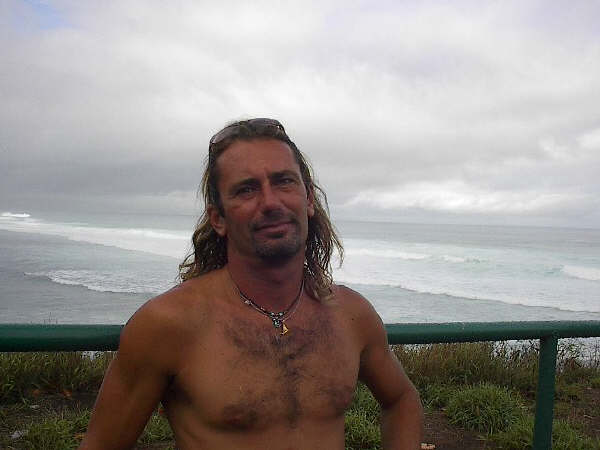Nnethelss, the photo shows the head and a half size, which this time I called correctly. Three days ago I called the same size from the cliff, but it was much bigger than that. That's because I didn't wait much (I went surfing somewhere else) and the swell was on the rise, so later on it was much bigger than early morning. Also, I call what's the average size, so whatever size I call, you can expect waves occasionally bigger than that. That is also true when I give a range of sizes. Example: shoulder to head high means that most of the waves are like that, but there could be occasional bigger sets. The other way you can gather the size of a swell at Hookipa is by reading the Pauwela buoy, which I only report at the time of the call, but you can (and should) check it again if you go surfing later than that. Link n.11.

5am significant buoy readings
South shore
No indication of southerly energy at the buoys, the Surfline forecast has nothing from the south. But check the discussion below for the westerly wrap in Kihei/north Lahaina.
North shore
NW101
11.5ft @ 16s from 278° (W)
8.8ft @ 12s from 278° (W)
4.2ft @ 10s from 275° (W)
W
10.4ft @ 16s from 318° (NW)
SW
5.5ft @ 13s from 318° (NW)
5.5ft @ 13s from 318° (NW)
Hanelei
13.3ft @ 15s from 312° (NW)
Waimea
12.1ft @ 14s from 304° (WNW)
Pauwela
7.1ft @ 17s from 324° (NW)
3.2ft @ 13s from 323° (NW)
2.8ft @ 8s from 44° (NE)
2.1ft @ 6s from 85° (E)
Lots to talk about today as a new extra large WNW swell is on the rise. Below is a map that shows the position of the NW101 buoy relative to the islands. A swell from 300 will be headed straight our way. As stated in the post Buoys to Maui travel times and Maui's shadow lines, the eastern end of Molokai will shelter everything coming from more west than 305 though, so also in that case there will be some shadowing. The point is that if the energy is from 285 for example (as it was most of the day up there yesterday) it will miss us to the north. That's why yesterday I wrote it's recording some westerly medium period energy that will never make it here. THAT energy will not make it here (but instead miss out to the north), but some other energy will. Specifically, the one that is where I drew the question mark and for that we have no indication, since there's no buoy in that position right west of Kauai. Of course there is some energy there and of course it will refract around the islands and we'll get a portion of it, we just don't know how much as we don't know how much of it is at the beginning, before the refraction.
Also notice how the energy will travel south of the lowest red line I drew (still 285 direction) and squeeze in the narrow channel between Molokai and Lanai. The shadow line for Kihei instead, is illustrated in the above mentioned post.
Based on the discussion above and on the fact that I've become more and more skeptical about the indication of the direction at the buoys, I feel like encouraging the use of the fetches maps as your qualitative source of direction indication. Also this one can be not 100% accurate though, because the maps are sampled once a day. The fetch might have moved or intensified during the 24 hours in between. Below is the collage of the maps of Jan 31, Feb 1 and 2. As you can see, yes, it was a pretty westerly fetch.

The collage below is interesting too. It's the Surfline forecast for:
1) Oahu's west shore
2) Maui's north shore (link n.15)
3) Maui's south shore (link n. 14)
Let's start from n.2, which only shows 307 as direction. That's because it already takes into consideration the refraction around all the islands. According to Surfline's algorithm (which is the WW3 model integrated with their near shore model), the swell will wrap and be 12f 15s from 307 degrees at sunset. Will it happen or not, that's their best effort and my favorite available online.
The other two maps show a component of the swell that is from 285. And also that is after the refraction, but this time around the south tips of the islands. It's obvious that there will never be any reading at Pauwela from that direction, because there can't be. Unless a meteorite hits the ocean just outside the Kahului harbor or massive land slide happens in kahakuloa and they make some waves, it's impossible that waves from that direction hit Pauwela, because the West Maui Mountains are there.
Based on the observation of the fetches, you would expect that the W and SW buoys would indicated a more westerly direction of the 318 that they both show, and that's why I'm starting to trust the direction at the buoys less and less. We'll see what reality will be, that's why I try to do beach reports also. They sometimes are more valuable than all the analysis one can make.
Webcams help a lot too, this are the two at Charley Young beach that show a decent shore break, so yes, there's waves in Kihei.

Wind map at noon shows light easterly trades. They didn't happen at all yesterday, confirming that unfortunately this model is not always correct. The cloud cover didn't help.
North Pacific shows the WNW fetch still in place, although much weaker than the past three days. It also shows a small E fetch, which is the reason of the lingering small short period energy still at the buoy.
South Pacific shows two fetches but:
- the one way SW of the Tasman Sea is so far away that I doubt that energy will find its way to us
- the one east of New Zealand is too weak
Morning sky.















2 comments:
Re: skepticism on wave direction, I'm sure you've seen this already but the buoys are not measuring direction directly but are deriving it. The raw data doesn't get transmitted and calibration would be infrequent. Definitely prone to error when things get bouncy. http://www.ndbc.noaa.gov/wave.shtml
thanks for the link!
Post a Comment